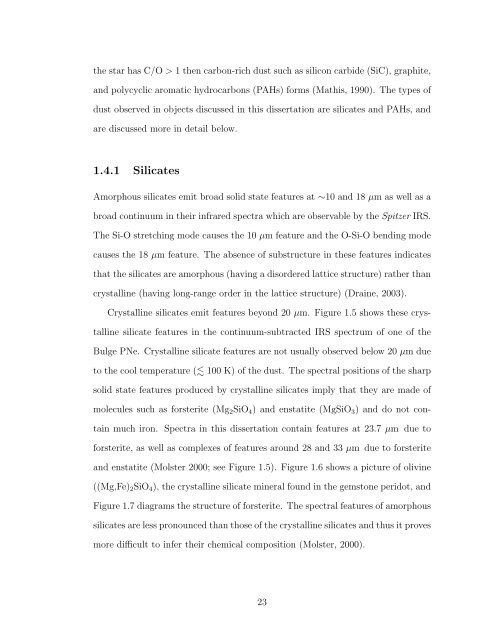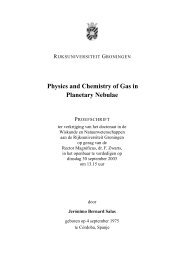TRACING ABUNDANCES IN GALAXIES WITH THE SPITZER ...
TRACING ABUNDANCES IN GALAXIES WITH THE SPITZER ...
TRACING ABUNDANCES IN GALAXIES WITH THE SPITZER ...
Create successful ePaper yourself
Turn your PDF publications into a flip-book with our unique Google optimized e-Paper software.
the star has C/O > 1 then carbon-rich dust such as silicon carbide (SiC), graphite,<br />
and polycyclic aromatic hydrocarbons (PAHs) forms (Mathis, 1990). The types of<br />
dust observed in objects discussed in this dissertation are silicates and PAHs, and<br />
are discussed more in detail below.<br />
1.4.1 Silicates<br />
Amorphous silicates emit broad solid state features at ∼10 and 18 µm as well as a<br />
broad continuum in their infrared spectra which are observable by the Spitzer IRS.<br />
The Si-O stretching mode causes the 10 µm feature and the O-Si-O bending mode<br />
causes the 18 µm feature. The absence of substructure in these features indicates<br />
that the silicates are amorphous (having a disordered lattice structure) rather than<br />
crystalline (having long-range order in the lattice structure) (Draine, 2003).<br />
Crystalline silicates emit features beyond 20 µm. Figure 1.5 shows these crys-<br />
talline silicate features in the continuum-subtracted IRS spectrum of one of the<br />
Bulge PNe. Crystalline silicate features are not usually observed below 20 µm due<br />
to the cool temperature (� 100 K) of the dust. The spectral positions of the sharp<br />
solid state features produced by crystalline silicates imply that they are made of<br />
molecules such as forsterite (Mg2SiO4) and enstatite (MgSiO3) and do not con-<br />
tain much iron. Spectra in this dissertation contain features at 23.7 µm due to<br />
forsterite, as well as complexes of features around 28 and 33 µm due to forsterite<br />
and enstatite (Molster 2000; see Figure 1.5). Figure 1.6 shows a picture of olivine<br />
((Mg,Fe)2SiO4), the crystalline silicate mineral found in the gemstone peridot, and<br />
Figure 1.7 diagrams the structure of forsterite. The spectral features of amorphous<br />
silicates are less pronounced than those of the crystalline silicates and thus it proves<br />
more difficult to infer their chemical composition (Molster, 2000).<br />
23













